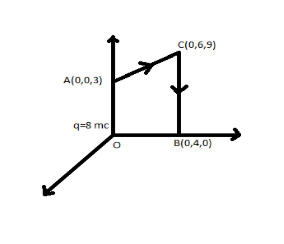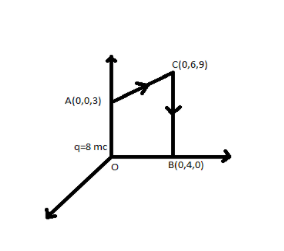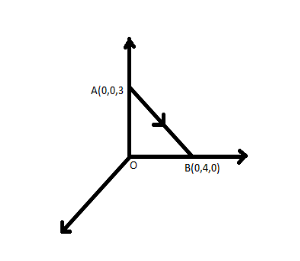
Calculate the work done in taking a charge $ - 2 \times {10^{ - 9}}C$ from A and B via C (in diagram).

A. 0.2 J
B. 1.2 J
C. 2.2 J
D. Zero

Answer
564.9k+ views
Hint:To calculate the work done in moving the charge from point A to point B firstly, calculate the potential at the point A and B respectively. Then, calculate the potential difference between the point A and B created due to charge present at the origin. At last multiply the calculated potential difference with the charge moving from point A and B.
Formula used: $W = {q_1}\left( {{V_B} - {V_A}} \right)$
Here, $q_1$ is the charge which moves. ${V_B}$ is the potential at B due to q and ${V_A}$ is the potential at A due to q.
Complete step by step answer:
In this question, we want to find out the work done in bringing a charge $ - 2 \times {10^{ - 9}}C$ from A to B via C. But as we know that moving a charge in electric field is independent of path chosen to move the charge in electric field and depends only on electric potential difference between them.

If charge directly moves from A to B then the result will be the same.

The only thing we need to do is to find the potential at A due to charge \[q = 8mc\] at the origin i.e., .
${r_{OA}} = $ Distance between origin and the point \[A = 3cm\].
Similarly, potential at B due to charge, \[q = 8mc\]at the origin
${r_{OB}} = $ Distance between origin and the point \[B = 4cm\].
$\therefore work\;done = {q_1}\left( {{V_B} - {V_A}} \right)$
Now, by substituting the values we get,
Now, putting all the values,
${q_1} = - 2 \times {10^{ - 9}}C$
$q = 8mc = 8 \times {10^{ - 3}}C$
${r_{OB}} = 4cm$
${r_{OA}} = 3cm$
$W = - 2 \times {10^{ - 9}} \times 8 \times {10^{ - 3}} \times 9 \times {10^9}\left( {\dfrac{1}{4} - \dfrac{1}{3}} \right)$
\[\;\therefore W = 1.27{\text{ }}J\;\] (Answer)
Note:Charge which is moving from one point to another is always multiplied to potential difference between the points, whatever the path of charge will be.
Formula used: $W = {q_1}\left( {{V_B} - {V_A}} \right)$
Here, $q_1$ is the charge which moves. ${V_B}$ is the potential at B due to q and ${V_A}$ is the potential at A due to q.
Complete step by step answer:
In this question, we want to find out the work done in bringing a charge $ - 2 \times {10^{ - 9}}C$ from A to B via C. But as we know that moving a charge in electric field is independent of path chosen to move the charge in electric field and depends only on electric potential difference between them.

If charge directly moves from A to B then the result will be the same.

The only thing we need to do is to find the potential at A due to charge \[q = 8mc\] at the origin i.e., .
${r_{OA}} = $ Distance between origin and the point \[A = 3cm\].
Similarly, potential at B due to charge, \[q = 8mc\]at the origin
${r_{OB}} = $ Distance between origin and the point \[B = 4cm\].
$\therefore work\;done = {q_1}\left( {{V_B} - {V_A}} \right)$
Now, by substituting the values we get,
Now, putting all the values,
${q_1} = - 2 \times {10^{ - 9}}C$
$q = 8mc = 8 \times {10^{ - 3}}C$
${r_{OB}} = 4cm$
${r_{OA}} = 3cm$
$W = - 2 \times {10^{ - 9}} \times 8 \times {10^{ - 3}} \times 9 \times {10^9}\left( {\dfrac{1}{4} - \dfrac{1}{3}} \right)$
\[\;\therefore W = 1.27{\text{ }}J\;\] (Answer)
Note:Charge which is moving from one point to another is always multiplied to potential difference between the points, whatever the path of charge will be.
Recently Updated Pages
A man running at a speed 5 ms is viewed in the side class 12 physics CBSE

The number of solutions in x in 02pi for which sqrt class 12 maths CBSE

State and explain Hardy Weinbergs Principle class 12 biology CBSE

Write any two methods of preparation of phenol Give class 12 chemistry CBSE

Which of the following statements is wrong a Amnion class 12 biology CBSE

Differentiate between action potential and resting class 12 biology CBSE

Trending doubts
What are the major means of transport Explain each class 12 social science CBSE

Which are the Top 10 Largest Countries of the World?

Draw a labelled sketch of the human eye class 12 physics CBSE

How much time does it take to bleed after eating p class 12 biology CBSE

Explain sex determination in humans with line diag class 12 biology CBSE

When was the first election held in India a 194748 class 12 sst CBSE




